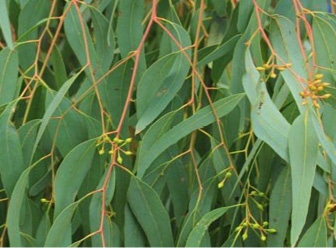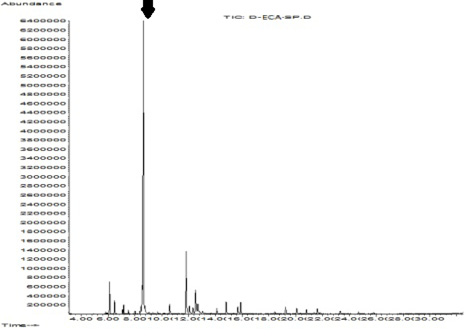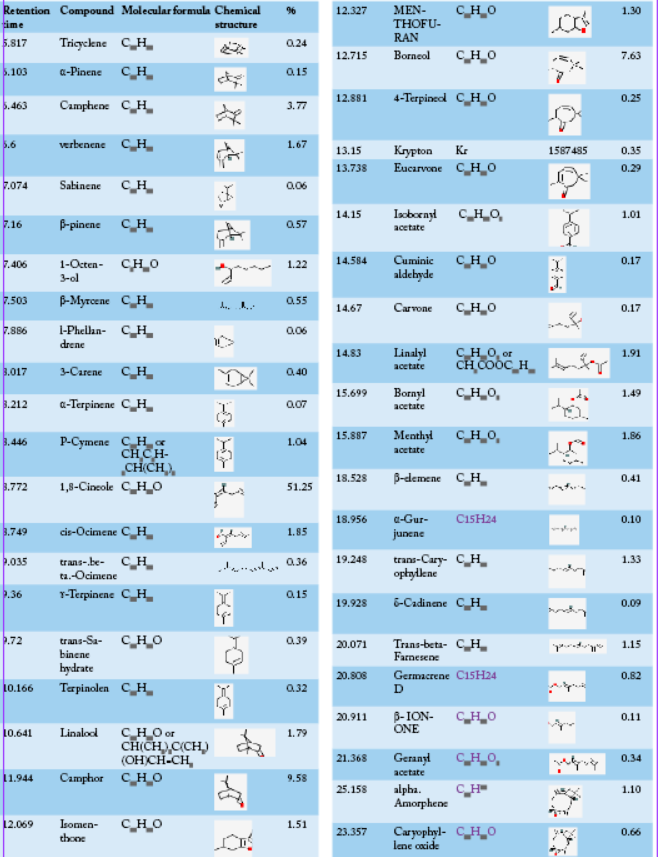Advances in Animal and Veterinary Sciences
Research Article
Extraction and Phytoanalysis of Chemical Compounds of Eucalyptus globulus Leaf Native to Dehloran, Ilam Province, Iran by HS-SPME and GC-MS
Naser Abbasi1, Zahra Khalighi2, Zohre Eftekhari3, Mahmoud Bahmani1*
1Biotechnology and Medical Plants Research Center, Ilam University of Medical Sciences, Ilam, Iran; 2Department of Internal Medicine, School of Medicine, Ilam University of Medical Sciences, Ilam, Iran; 3Quality Control Department, Research and Production Complex, Pasteur Institute of Iran, Tehran, Iran.
Abstract | Eucalyptus globulus Labill. belongs to the Myrtaceae family, which extracted essential oils uses for medicinal, nutritional, and ornamental purposes. The present study conducted to extract the essential oil of Dehloran native eucalyptus leaf and recognize its biochemical components by the HS-SPME method. The eucalyptus leaf collected from Dehloran city, Ilam province, in October 2019. The leaves were dried for 72 hours at standard temperature and powdered. The essential oils and their volatiles extracted by solid-phase microextraction in the head space (HS-SPME) and their biochemical components analyzed by GC-MS. The final results revealed that the essential oil includes 43 composites that 1,8-cineol with 51.25% was the most important chemical composition of Eucalyptus leaves essential oil. Camphor (9.58%), borneol (7.63%), and camphene (3.77%) were the other most important compounds identified. The major identified compounds were bicyclic monoterpenes, aromatic terpenoids, cyclic ether, and terpenes. It concluded that Eucalyptus culture in Dehloran, with a high amount of 1, 8-cineol has high pharmaceutical and healthful value.
Keywords | Essential oil, Eucalyptus globulus Labill., 1, 8-cineol, HS-SPME, GC-MS
Received | January 13, 2020; Accepted | May 27,2020; Published | June 01, 2020
*Correspondence | Dr. Mahmoud Bahmani, Biotechnology and Medicinal Plants Research Center, Ilam University of Medical Sciences, Ilam, Iran; Email: Mahmood.bahmani@gmail.com
Citation | Abbasi N, Khalighi Z, Eftekhari Z, Bahmani M (2020). Extraction and phytoanalysis of chemical compounds of Eucalyptus globulus leaf native to dehloran, Ilam Province, Iran by HS-SPME and GC-MS. Adv. Anim. Vet. Sci. 8(6): 647-652.
DOI | http://dx.doi.org/10.17582/journal.aavs/2020/8.6.647.652
ISSN (Online) | 2307-8316; ISSN (Print) | 2309-3331
Copyright © 2020 Abbasi et al. This is an open access article distributed under the Creative Commons Attribution License, which permits unrestricted use, distribution, and reproduction in any medium, provided the original work is properly cited.
INTRODUCTION
Essential oil is a concentrated liquid, contains volatile chemical compounds derived from medicinal plants, which often used as additives in the formulation of foods, beverages, perfumes, medicines, and cosmetics. One of the medical plants that have volatile essential oils is Eucalyptus globulus Labill., which belongs to the Myrtaceae family and is native to Australia and nowadays cultivate worldwide (Dhakad et al., 2018; Aziz et al., 2018). E. globulus is a tree that naturally grows to a height of 60-80 m. The bark of plant with brown or yellowish-brown color is mostly smooth, shedding in long strips to leave a white or greyish surface that is resistant to rot and can easily separate from the stem. Its leaf color also depends on the age of the tree (initially blue-green and over time greenish-white) (Pereira et al., 2014; Tyagi et al., 2011; Araujo et al., 2010). The flower buds are organized singly in leaf axils on a condensed peduncle that is sessile or up to 5 mm long. The peak of flowering occurs between May and January, which are white with numerous stamens in white or cream or yellow or red color.
Additionally, the fruits of E. globulus are a woody semicircular capsule form with the valves close by edge level (Mason et al., 2000; Mulyaningsih et al., 2010; Nakhaee et al., 2009). Eucalyptus’s therapeutic properties include antiseptic, anti-parasitic, insect repellent, anti-rheumatism, anti-migraines, anti-urinary tract infections, anti-ulcer burns, febrifuge, and anti-fatigue (Adebola et al., 1999; Abdollahzade et al., 2012; Zaiton et al., 2018). Since eucalyptus leaves are widely used in this region, it is important to identify their chemical constituents. Eucalyptus essential oil widely uses as a traditional medicine in many parts of the world to the treatment of different diseases and disorders (Zaiton et al., 2018). Previous studies showed that prescription of traditional doses of E. globulus essential oil dissolved in water by transdermal rout up to 4–7 g/100 L had an impressive effect (Committee on Herbal Medicine Product, 2013).
The most prominent extraction compounds of the Eucalyptus leaf include 1, 8-Cineole, and Eucalyptol (Adebola et al., 1999; Abdollahzade et al., 2012). Phytochemical studies have shown that the main ingredient of the E. globulus essential oil is 1, 8-Synolol (Silva et al., 2003). Eucalyptol or 1, 8-Cineole is a compound with the chemical formula C10H18O is a compound with the identity of pub. Its molar mass is 154.249 g/mol. There are various other names for this combination of liquid and colorless natural organic such as Cajeputol, Oxido-p-menthane and Limonen-1, 8-oxid. 1, 8-Cineole has phlegmic, bactericidal and anti-inflammatory effects. It is a cyclic ether and a monoterpene. Eucalyptol is a natural constituent of a number of aromatic plants and their essential oil fraction (Silva et al., 2003). Whereas many varieties of medicinal plants are rich in odorant and volatile compounds, and these volatile oils have significant roles in the pharmaceutical, agrochemical, aromatherapy, and food flavorings of humans. The aim of the present study was investigation the chemical composition of the essential oil of E. globulus leaves collected from Dehloran in Ilam province, Iran as an important geographical zone for medicinal plants, by Head space Solid Phase Microextraction (HS-SPME) method.
MATERIALS AND METHODS
Preparation of medicinal plants
Eucalyptus leaves (Figure 1) collected from the Dehloran district (a latitude of 32°41’31.91”N and a longitude of 47°16’4.64”E or 32.692197 and 47.267956 respectively), Ilam province located in western of Iran during the October 2019. The Eucalyptus leaves dried for 72 hours at a standard temperature. Then, using a mixer powder prepared and finally, the essential oils and its volatility examined and characterized by the solid phase micro-extraction (HS-SPME) method.
Identification of chemical compounds by HS-SPME
In this experiment, the essential oil of the plant was extracted by HS-SPME technique. In this technique, about 2 grams of dried plant and its powder were placed in the vial and the vial temperature was set at 60-70 °C. These optimum temperature conditions will saturate the vapor content of the substances in the plant essential oil in the headspace of the solid surface. The SPME syringe with a lid on it was then placed in the headspace of the container and the material in the vapor waz absorbed by the silica phase in the instrument needle. After the silica fiber was allowed to sufficiently saturate with volatile components, the fiber was directly placed into the GC/MS input section and materials present in the fiber were adsorbed due to the temperature of the input and then entered into the GC/MS apparatus for identification (Hashemi et al., 2012).

Picture 1: Eucalyptus globulus plant.
HS-SPME method
2 g of each plant extract was used for analysis. The device condition was as follows: Gas chromatograph (Agilent6890N) was coupled to Agilent 5973 Mass detector; Column: HP - 5. (30 m length × 0.25 mm (ID) × 0.25 μm (stationary phase thickness); Injector type: split/splitless and column temperature program: 50 oC, hold time 0.00 min and rate of -oC/min; temperature 200 oC, hold time, 0.00 min and rate of 5oC/min and temperature 240 ⁰C, hold time 0.00 min and rate of 10 oC/min. Carrier gas: He (99.999%); Injection type: splitless; Library: Wiley 7n;
Injector temperature: 250 °C and flow rate: 0.9 mL/min. Extraction mode: (HSSPME); SMPE fiber: PDMS 100 μm thickness (SUPELCO); sample weight: 0.5 g; extraction temperature: 60 oC; extraction time: 20 min; sonication time: 10 min (Euronda sonication instrument, Italy) and desorption time in GC-MS injector port: 3 min (Bahmani et al., 2019).
RESULTS
In the beginning, the volatile essential oils extracted by solid-phase microextraction in the head space (HS-SPME), and then the essential oils analyzed by GC-MS. Based on the results, 43 compounds identified by the HS-SPME method in the isolated essential oil. 1, 8-cineol with 51.25% was the highest chemical composition of Eucalyptus essential oil (Table 1, Figure 1). The other important identified compounds of Eucalyptus essential oil were champhor (9.58%), borneol (7.63%), and camphene (3.77%), respectively. Other information and details of the identified chemical compounds mentioned in Table 1 and Figure 1.
Properties of 1, 8-Cineole such as chemical formula, Molar mass, Density, Melting point, Boiling point and Magnetic susceptibility (χ) listed in Table 2.
Table 2: Properties of 1, 8-Cineole.
| Properties of 1, 8-Cineole | |
| Chemical formula |
C10H18O |
| Molar mass | 154.249 g/mol |
| Density |
0.9225 g/cm3 |
| Melting point | 2.9 °C (37.2 °F; 276.0 K) |
| Boiling point | 176–177 °C (349–351 °F; 449–450 K) |
|
Magnetic susceptibility (χ) |
−116.3×10−6 cm3/mol |
The results achieved from the chromatogram in Figure 1 revealed that the essential oil of Eucalyptus comprises 43 compounds. The major components identified include bicyclic monoterpenes, aromatic terpenoids, cyclic ether, and terpenes.
DISCUSSION
Until now, over 700 tree species and bushes belonging to the Eucalyptus recognize in the world. It belongs to the family Myrtaceae and found in most tropical regions of the world (Boland et al., 1991). In this study, Eucalyptus leaf collected from Dehloran city, the western region of Iran, located in the Ilam province. Based on obtained results and in agreement with previous studies, the major ingredient of volatile essential oils of Eucalyptus species is 1, 8-cineole (Carmen et al., 2003).
These compounds use as a raw material for pharmaceutical and cosmetic industries (Carmen et al., 2003). The essential oils of Eucalyptus used in softeners, ointments, anti-cough syrups, toothpaste, and as flavorings for some medicines. It also utilized as an aromatic in the manufacture of soaps, powders, detergents, and perfumes (Juergens et al., 2003). Studies showed that the most valuable standard essential oil compositions of Eucalyptus species in southern, and southwestern Australia include Alpha-pinene, Beta-pinene, 1,8-cineole, Paracymin, Aromadendrene, Bicyclomeracorn, and Spatolenol (Bignell et al., 1996). The HS-SPME method is best suited for a volatile sample. Protects fiber from damage to matrix interference because fiber is not in direct contact with the matrix. Herbal active ingredients have always been very important in various researches and these compounds have medicinal and therapeutic properties against a variety of diseases such as chronic, non-chronic, infectious and non-infectious disorders and diseases (Abbasi et al., 2016; Beiranvand and Alizadeh, 2019; Asef et al., 1997; Bahmani et al., 2019; Karimi et al., 2019; Moayeri et al., 2018; Karimian, 2019; Valadi et al., 2010; Bamoniri et al., 2009; Jabbari et al., 2019).
CONCLUSION
The time of harvesting of plant organs is one of the most important factors affecting the amount of medicinal plant efficacy, and the main components of Eucalyptus essential oil collected in the summer season. Eucalyptus broadly uses in traditional medicine, and its essential oil is one of the most effective and common drugs, which many of these effects are most likely due to 1,8-cineol as its active ingredient. Comparison of the active components of Eucalyptus species essential oil shows that the monoterpene oxygenated composition of 1, 8-cineol is the main common ingredient of all eucalyptus species and the main difference is only in the percentage of this compound. In the present study, more than 50% of the essential oil of the leaf was 1, 8-cineole, so it has a high pharmaceutical benefit for the cosmetics, health and pharmaceutical industries. Therefore, the essential oil of Eucalyptus tree leaf grown in the region can use in pharmaceutical, health and cosmetic industries.
ACKNOWLEDGMENTS
Authors would like to thank the Vice-chancellor for the Research and Technology Deputy of the Ilam University of Medical Sciences and Biotechnology and Medicinal Plants Research Center for funding this study.
AUTHORS CONTRIBUTION
MB reviewed the literature and prepared the first draft of manuscript; ZKH, ZE, MB and NA reviewed the literature, helped in preparing first draft of manuscript, checked and corrected the grammar. All authors read and approved the final report.
CONFLICT OF INTERESTS
All authors have declared no conflict of interest.
FUNDING/SUPPORT
Biotechnology and Medicinal Plants Research Center, Ilam University of Medical Sciences was supported this research.
REFERENCES







